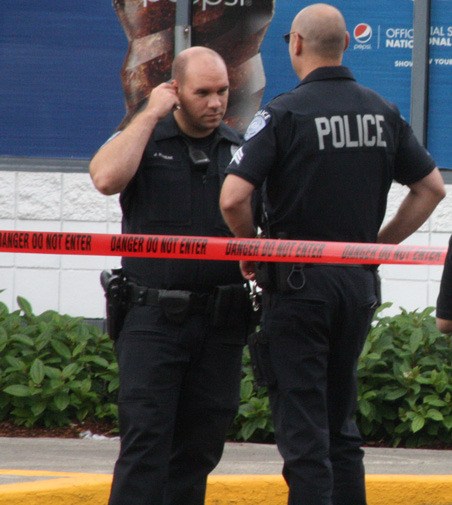The Kent Police Department has the largest percentage-point differences of white officers to white residents in the state with a 39 percent difference, according to a recent New York Times story.
Kent isn’t alone. The percentage of whites on the force is more than 30 percentage points higher than in the communities they serve in hundreds of police departments across the nation, according to The Bureau of Justice Statistics report quoted by the paper under the headline of The Race Gap in America’s Police Departments. The survey sampled more than 100 police agencies in 15 metropolitan areas.
“I hate to be the top one in the region,” Kent Police Chief Ken Thomas said in response to the story. “That’s something you don’t want to be number one in.”
But Thomas, who is white and took over as police chief in 2011, said he has worked hard and continues to work to increase the number of minorities hired by the Kent Police.
“We are making diversifying the police department a high priority and we continue to make that transition,” Thomas said. “But numbers are what numbers are. We need to do better and we are working to do better.”
Thomas disputes the New York Times numbers that are from a 2007 survey when Kent had a 92,000 population and 128 officers. The city now has more than 120,000 residents and 138 officers.
Kent has a 55 percent white population, according to the 2010 U.S. Census American Community Survey. The leading minority populations include 16 percent Hispanic/Latino, 15 percent Asian and 11 percent African American. The police force has 85 percent white officers as of Aug. 25, according to numbers provided by the Kent Police.
That makes the percentage-point differences of white officers to white residents in Kent at 30 percent.
“It’s a process,” Thomas said of increasing minority hires. “It takes time. Nobody likes to hear that.”
City Councilwoman Brenda Fincher, who is black, agreed with Thomas that Kent continues to take positive steps by hiring more minorities.
“I’ve seen progress moving in the right way,” said Fincher, who started to monitor police hires as a private citizen in the 1990s. “Chief (Thomas) is willing to sit down, talk, listen and take action. We are definitely making progress but progress is never fast enough.”
Kent has hired 68 percent white officers and 32 percent minority since 2011, Thomas said.
“That shows we’re trying to make real progress and bring diversity into the department,” Thomas said.
After Kent hires officers from the police academy or other police departments, they serve a one year probation period. Numerous officers do not pass probation, making it difficult to increase minority numbers rapidly.
“We have extra high standards at the police department,” Thomas said. “We lose quite a few during the probation period.”
Seven white officers and six minority officers recently failed to pass probation, the chief said.
The hiring process of police officers also impacts the hires.
“We can’t just handpick people to work for us,” Thomas said. “We follow strong civil service guidelines and testing policies (through publicsafetytesting.com).”
Physical and written tests eliminate some candidates before Kent even gets a list of potential hires.
“We deal with a somewhat limited candidate pool,” Thomas said.
Despite the challenges, Thomas said the department is becoming more diverse. He said a study will start next month to try to determine ways to reduce the number of candidates lost during testing and field training.
“The evidence shows we really are reaching out to diverse candidates to help make the police department more reflective of the community,” he said.
Thomas added the force also continues to reach out to the diverse community in Kent.
“We’re working hard to do a better job and we are going to get there,” he said.
Fincher took ride-alongs with Kent Police officers and came away impressed with how well they interact with residents, including the diverse communities.
“It has to do with training and getting out into the community to learn about people, especially here since we have such a diverse community,” Fincher said. “On a ride-along I saw people waving at the police and engaging in conversations.”
Fincher said she’s pleased Kent continues to look to hire more minorities.
“We’re expanding but there is work to be done,” she said. “We have a lot o long-term officers who through attrition will be gone. We need to make sure we look far and wide when we hire somebody.”
As far as the New York Times story and survey, Fincher said it surprised her how white police forces are across the nation.
“It’s changing more slowly in sections of the country than I thought,” she said.
Other Washington cities listed in the report and the percentage-point differences of white officers to white residents included Lakewood (plus 33 percent); Federal Way (plus 33); Redmond (plus 27); Mountlake Terrace (plus 26); Bellevue (plus 26); Tacoma (plus 24); Everett (plus 20); and Edmonds (plus 10).
Kent Police, community charts
• Kent demographics
White 55.5 percent
Hispanic/Latino 16.6
Asian 15.2
African American 11.3
Pacific Islander 1.9
Native American 1.0
Other 8.5
Two or more 6.6
Source: U.S. Census 2010
• Kent Police force
White 85.2 percent
Asian 5.9
Black 3.7
Hispanic 3.7
American Indian/Alaskan Native 1.0
Source: Kent Police, August 2014
Talk to us
Please share your story tips by emailing editor@kentreporter.com.
To share your opinion for publication, submit a letter through our website https://www.kentreporter.com/submit-letter/. Include your name, address and daytime phone number. (We’ll only publish your name and hometown.) Please keep letters to 300 words or less.

